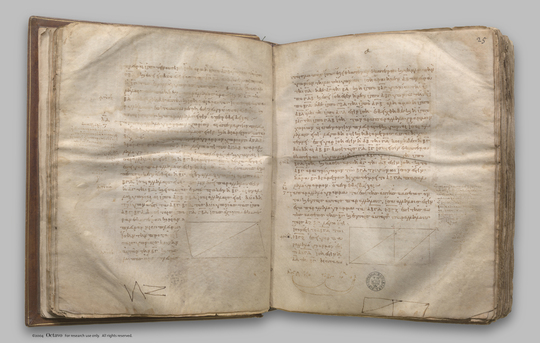index prev next | digilib folio 29

In parallelogrammic areas the opposite sides and angles are equal to one another, and the diameter bisects the areas.
| Τῶν παραλληλογράμμων χωρίων αἱ ἀπεναντίον πλευραί τε καὶ γωνίαι ἴσαι ἀλλήλαις εἰσίν, καὶ ἡ διάμετρος αὐτὰ δίχα τέμνει. Ἔστω παραλληλόγραμμον χωρίον τὸ ΑΓΔΒ, διάμετρος δὲ αὐτοῦ ἡ ΒΓ: λέγω, ὅτι τοῦ ΑΓΔΒ παραλληλογράμμου αἱ ἀπεναντίον πλευραί τε καὶ γωνίαι ἴσαι ἀλλήλαις εἰσίν, καὶ ἡ ΒΓ διάμετρος αὐτὸ δίχα τέμνει. Ἐπεὶ γὰρ παράλληλός ἐστιν ἡ ΑΒ τῇ ΓΔ, καὶ εἰς αὐτὰς ἐμπέπτωκεν εὐθεῖα ἡ ΒΓ, αἱ ἐναλλὰξ γωνίαι αἱ ὑπὸ ΑΒΓ, ΒΓΔ ἴσαι ἀλλήλαις εἰσίν. πάλιν, ἐπεὶ παράλληλός ἐστιν ἡ ΑΓ τῇ ΒΔ, καὶ εἰς αὐτὰς ἐμπέπτωκεν ἡ ΒΓ, αἱ ἐναλλὰξ γωνίαι αἱ ὑπὸ ΑΓΒ, ΓΒΔ ἴσαι ἀλλήλαις εἰσίν. δύο δὴ τρίγωνά ἐστι τὰ ΑΒΓ, ΒΓΔ τὰς δύο γωνίας τὰς ὑπὸ ΑΒΓ, ΒΓΑ δυσὶ ταῖς ὑπὸ ΒΓΔ, ΓΒΔ ἴσας ἔχοντα ἑκατέραν ἑκατέρᾳ καὶ μίαν πλευρὰν μιᾷ πλευρᾷ ἴσην τὴν πρὸς ταῖς ἴσαις γωνίαις κοινὴν αὐτῶν τὴν ΒΓ: καὶ τὰς λοιπὰς ἄρα πλευρὰς ταῖς λοιπαῖς ἴσας ἕξει ἑκατέραν ἑκατέρᾳ καὶ τὴν λοιπὴν γωνίαν τῇ λοιπῇ γωνίᾳ: ἴση ἄρα ἡ μὲν ΑΒ πλευρὰ τῇ ΓΔ, ἡ δὲ ΑΓ τῇ ΒΔ, καὶ ἔτι ἴση ἐστὶν ἡ ὑπὸ ΒΑΓ γωνία τῇ ὑπὸ ΓΔΒ. καὶ ἐπεὶ ἴση ἐστὶν ἡ μὲν ὑπὸ ΑΒΓ γωνία τῇ ὑπὸ ΒΓΔ, ἡ δὲ ὑπὸ ΓΒΔ τῇ ὑπὸ ΑΓΒ, ὅλη ἄρα ἡ ὑπὸ ΑΒΔ ὅλῃ τῇ ὑπὸ ΑΓΔ ἐστιν ἴση. ἐδείχθη δὲ καὶ ἡ ὑπὸ ΒΑΓ τῇ ὑπὸ ΓΔΒ ἴση. Τῶν ἄρα παραλληλογράμμων χωρίων αἱ ἀπεναντίον πλευραί τε καὶ γωνίαι ἴσαι ἀλλήλαις εἰσίν. Λέγω δή, ὅτι καὶ ἡ διάμετρος αὐτὰ δίχα τέμνει. ἐπεὶ γὰρ ἴση ἐστὶν ἡ ΑΒ τῇ ΓΔ, κοινὴ δὲ ἡ ΒΓ, δύο δὴ αἱ ΑΒ, ΒΓ δυσὶ ταῖς ΓΔ, ΒΓ ἴσαι εἰσὶν ἑκατέρα ἑκατέρᾳ: καὶ γωνία ἡ ὑπὸ ΑΒΓ γωνίᾳ τῇ ὑπὸ ΒΓΔ ἴση. καὶ βάσις ἄρα ἡ ΑΓ τῇ ΔΒ ἴση. καὶ τὸ ΑΒΓ [ ἄρα ] τρίγωνον τῷ ΒΓΔ τριγώνῳ ἴσον ἐστίν. Ἡ ἄρα ΒΓ διάμετρος δίχα τέμνει τὸ ΑΒΓΔ παραλληλόγραμμον: ὅπερ ἔδει δεῖξαι. | In parallelogrammic areas the opposite sides and angles are equal to one another, and the diameter bisects the areas. Let ACDB be a parallelogrammic area, and BC its diameter; I say that the opposite sides and angles of the parallelogram ACDB are equal to one another, and the diameter BC bisects it. For, since AB is parallel to CD, and the straight line BC has fallen upon them, the alternate angles ABC, BCD are equal to one another. [I. 29] Again, since AC is parallel to BD, and BChas fallen upon them, the alternate angles ACB, CBD are equal to one another. [I. 29] Therefore ABC, DCB are two triangles having the two angles ABC, BCA equal to the two angles DCB, CBD respectively, and one side equal to one side, namely that adjoining the equal angles and common to both of them, BC; therefore they will also have the remaining sides equal to the remaining sides respectively, and the remaining angle to the remaining angle; [I. 26] therefore the side AB is equal to CD, and AC to BD, and further the angle BAC is equal to the angle CDB. And, since the angle ABC is equal to the angle BCD, and the angle CBD to the angle ACB, the whole angle ABD is equal to the whole angle ACD. [C.N. 2] And the angle BAC was also proved equal to the angle CDB. Therefore in parallelogrammic areas the opposite sides and angles are equal to one another. I say, next, that the diameter also bisects the areas. For, since AB is equal to CD, and BC is common, the two sides AB, BC are equal to the two sides DC, CB respectively; and the angle ABC is equal to the angle BCD; therefore the base AC is also equal to DB, and the triangle ABC is equal to the triangle DCB. [I. 4] Therefore the diameter BC bisects the parallelogram ACDB. |